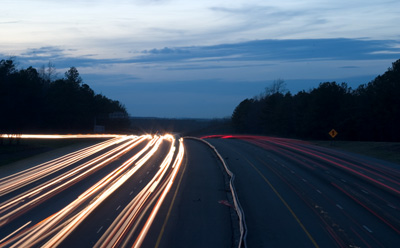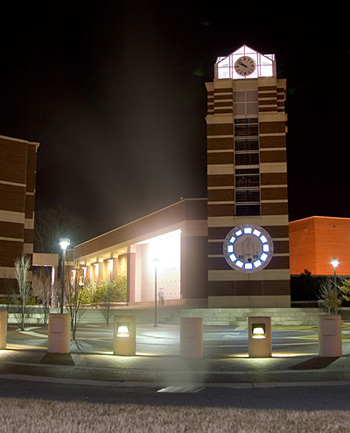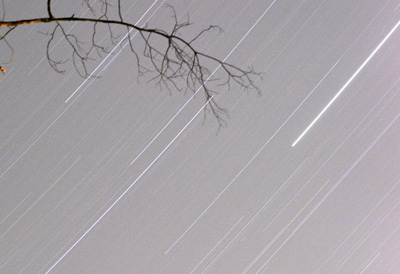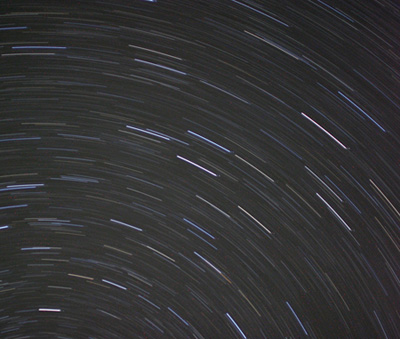AnandTech Guide to Better Photos: Night Photography
by Stephen Caston on February 18, 2005 12:05 AM EST- Posted in
- Digital Camera
Capturing Motion
One of the great things about night photography is using long exposures to create interesting effects. By exposing a scene for a couple seconds or more, you can capture images that we cannot see with our naked eyes. One of the most commonly-used ways to exploit this phenomenon is by taking long exposures of moving cars.
(10 sec., f/25, ISO 100)
Click to enlarge.
In the example above, we took a 10-second exposure while standing on an overpass above I-40. By taking the picture just after the sun went down, we were able to capture some detail in the sky.
If you ever get bored, another cool thing to do is to face your camera towards you. Set the camera to a long exposure and step back several feet. Then, use a flashlight, lighter, etc. to "draw" in the air. Check the results and tweak the aperture setting until you can get good clean results. There are people such as Tokihiro Sato who have turned this into an interesting form of photo art. We highly recommend experimenting with this because there are a lot of really creative things that you can do.

(10 sec, f/5.6, ISO 100)
Click to enlarge.
When you are looking for good, long exposure opportunities, keep an eye out for any kind of movement. The results can make your images seem a bit unreal. In the example above, the steam coming from the grate in the bottom center of the frame adds a mystical quality to the image. Over the course of the 10-second exposure, the steam created the effect of a ghostly figure rising from the ground.

(30 sec., f/16, ISO 400)
Click to enlarge.
In the picture above, the clouds were moving at a slow pace. After exposing the frame for 30 seconds, the clouds smoothed out creating a soft surreal effect (it almost looks like a parallax sky from Duke3d). If we had exposed this image for much longer, the detail in the clouds would have been lost.
Photographing the night sky is something that can be very rewarding, but it requires a lot of patience. Of course, you will want to use your camera's lowest ISO setting and experiment with different exposure times. However, one of the biggest problems with taking pictures of the sky is light pollution. Light pollution is most frequently caused by city lights shining into the sky. The result is that your sky images are going to be very bright when they are exposed for a long period of time. Below is an example
| Light Pollution |
 (60 min., f/5.6, ISO 100) Click to enlarge. |
In the picture above, our star image suffers from strong light pollution even though the sky looked pitch black and we were 30 miles from Raleigh, NC in a fairly rural town. If you are looking to capture anything in the sky with a long exposure, make sure that you are very far from any major cities or other sources of light pollution.

(30 min., f/2.5, ISO 100)
Click to enlarge.
In the example above, we found ourselves far from civilization in the wilderness of Maine. With a 30-minute exposure, we were able to capture an interesting pattern of movement.
We hope that this guide has inspired you to experiment with the fun of night photography. If you have tried before and the results weren't as good as you had expected, don't give up. Just keep an eye on your settings and shoot in several different locations. Night photography is no different from any other kind of photography in the sense that there seems to be no end to the possibilities. Once you have the technique down, the hardest part is to use your creativity to see beyond what is in front of your eyes. A long exposure can create interesting and dramatic effects with a seemingly "normal" subject. Good luck and the next time you have the urge to take pictures, don't let the night stop you!










20 Comments
View All Comments
Jeff7181 - Friday, February 18, 2005 - link
I didn't quite understand the flashlight/lighter technique... are you pointing them at the lense, or holding them under the lense, or...?apriest - Friday, February 18, 2005 - link
I just happen to live "far from civilization in the wilderness of Maine"! Haha! We do have a beautiful dark sky and it's great for star gazing. I've taken quite a few good pictures with slides on my old Canon AE-1, but haven't had much luck with my new digital Nikon D-70. I was going to attempt Gatak's suggestion of stacking multiple photos to create a virtual longer exposure, but haven't had the time to attempt it. Max Lyons has a wicked cool website with some software he has written to do just that. http://www.tawbaware.com/index.html Check out Image Stacker. Lots of other great software there too.PrinceGaz - Friday, February 18, 2005 - link
I find that it is possible to take night pictures of buildings (pubs) without a tripod or a convenient place to rest the camera on or against, just by using continuous shooting mode. The important thing is to hold your breath while the shots are being taken, and at all costs prevent any rotational movement of the camera (a few millimeters sideways or up/down movement is okay though).Provided the exposure isn't too long (1/2 sec is the most I ever usually need, around about 1/4 sec is more common) there's almost always one or two of any set of five shots that is pin sharp. If all of them are blurred, just fire off another set of shots until you get a good one. That's the beauty of digicams, you could never do that with old film cameras :)
stephencaston - Friday, February 18, 2005 - link
We used a Canon 10D for the star pictures. Thanks for all the comments and remember we are open to suggestions for future guides.Gatak - Friday, February 18, 2005 - link
Good article =) Night photography can be fun and give many interesting effects.A small tip. If your camera doesn't support very long exposures, or if it gives very high noise levels with lots of hot pixels you can take several (5-10 or more!) pictures with low exposure. Then you can add them together in Photoshop or with special tools to create a virtual long exposure. The result would have very little noise and high dynamic range too.
hoppa - Friday, February 18, 2005 - link
It should be noted in the article that, even though the guide is aimed towards beginners, the photos are taken with a DSLR capable of getting far smaller aperatures than ANY normal digicam could. f25 in that dusk shot? Very few digicams go above f8.7, and therefore couldn't even come close to getting those shots.They are neat photos but they seem like a waste of space to me; anyone who plops down $1000+ on a camera isn't going to be learning techniques from AT photo guides.
eosguy - Friday, February 18, 2005 - link
Good article.Also, it is important to cover the viewfinder in SLR cameras when taking long exposures. Also, try not to point the lens towards any light source to minimize occurance of Flare like in your cloud shot.
Souka - Friday, February 18, 2005 - link
Look forward to reading this... lotta open windows to peek into.....*JK*
sideshow23bob - Friday, February 18, 2005 - link
What camera was used on the long-lasting exposure pics at the end of the article?Nice article...yeah I-40.
gustavowoltmann1996 - Friday, March 26, 2021 - link
Really to do photography is an art. I love to do this and I am a Yoga Teacher (Gustavo Woltmann)